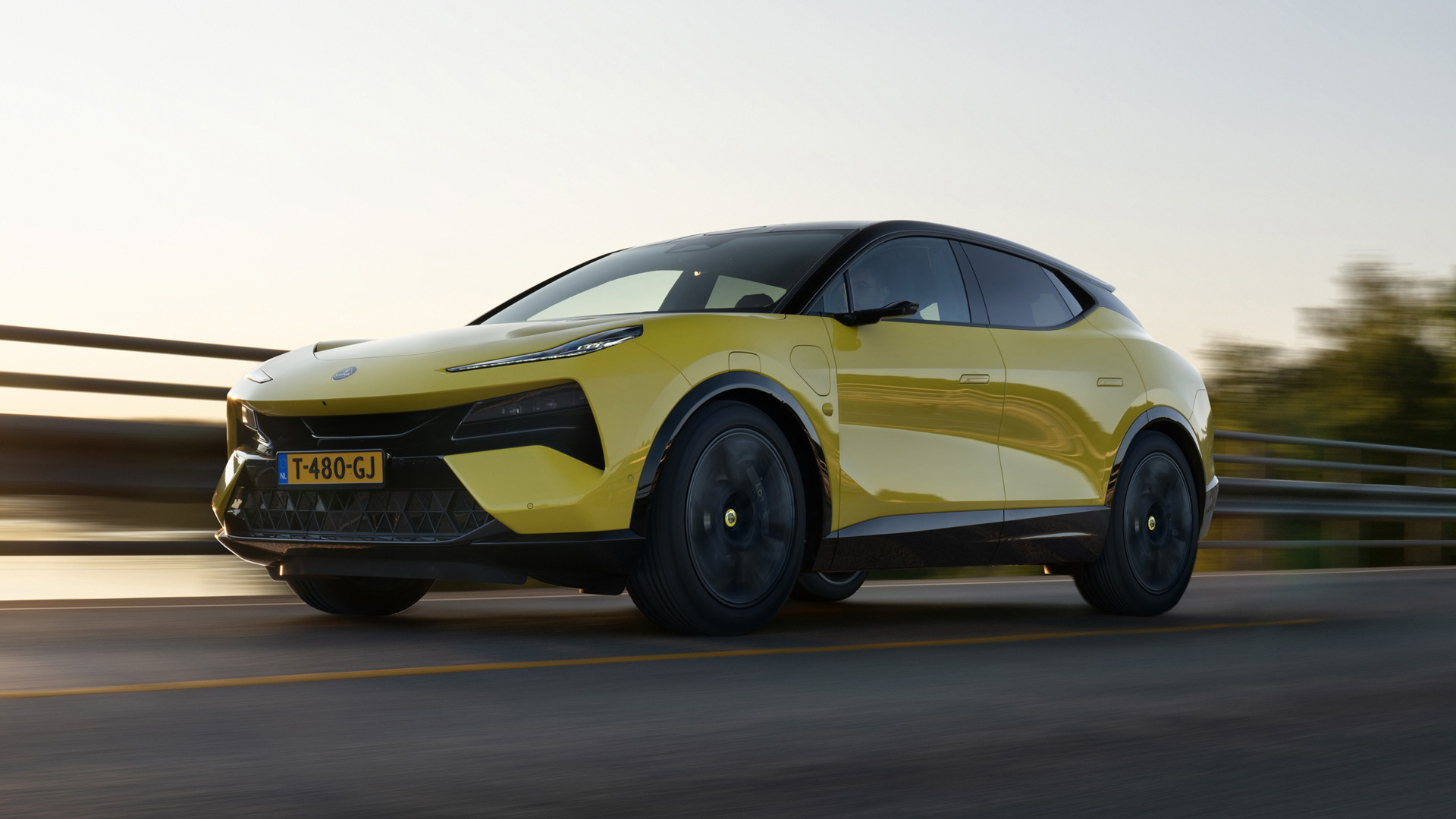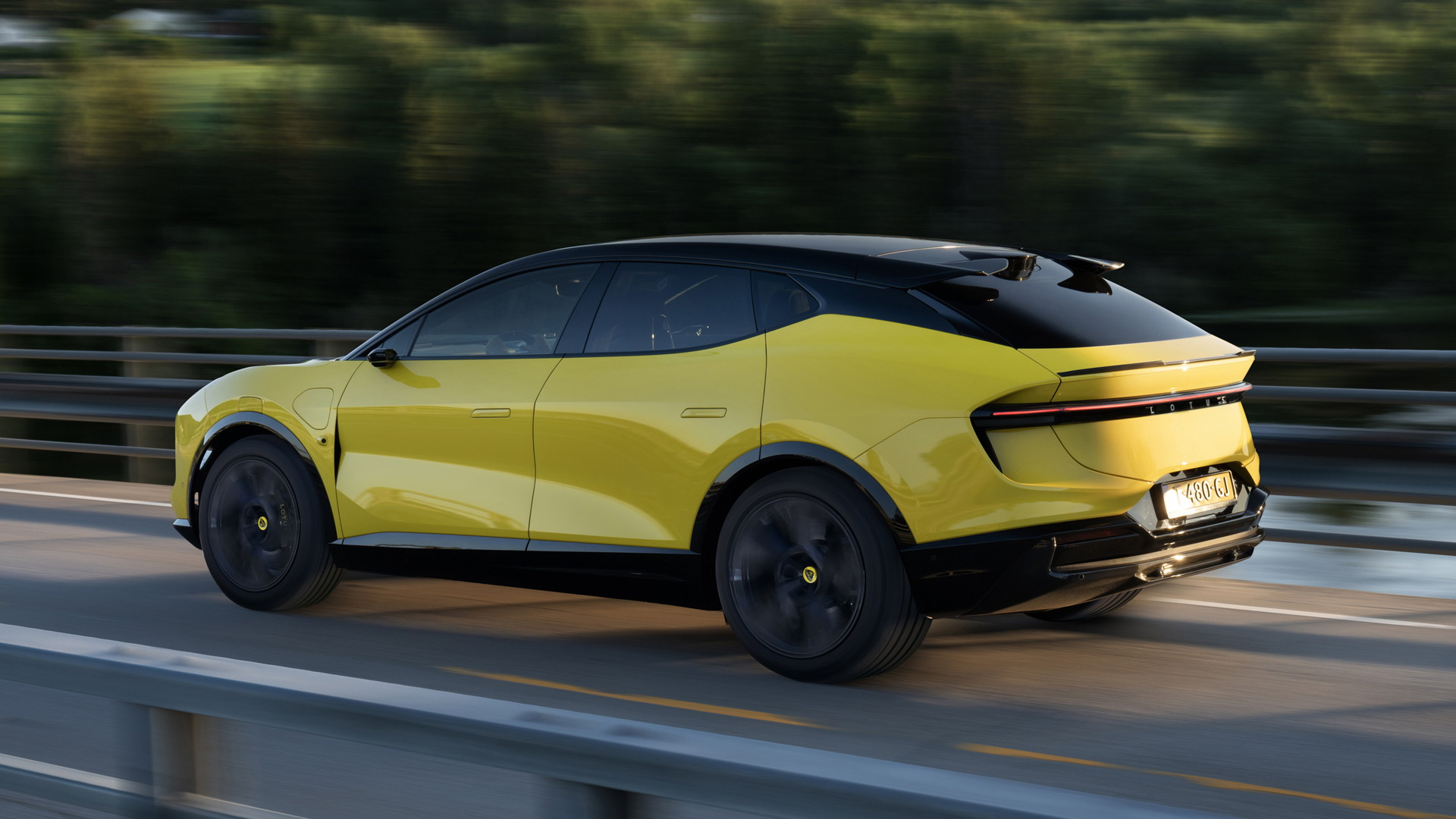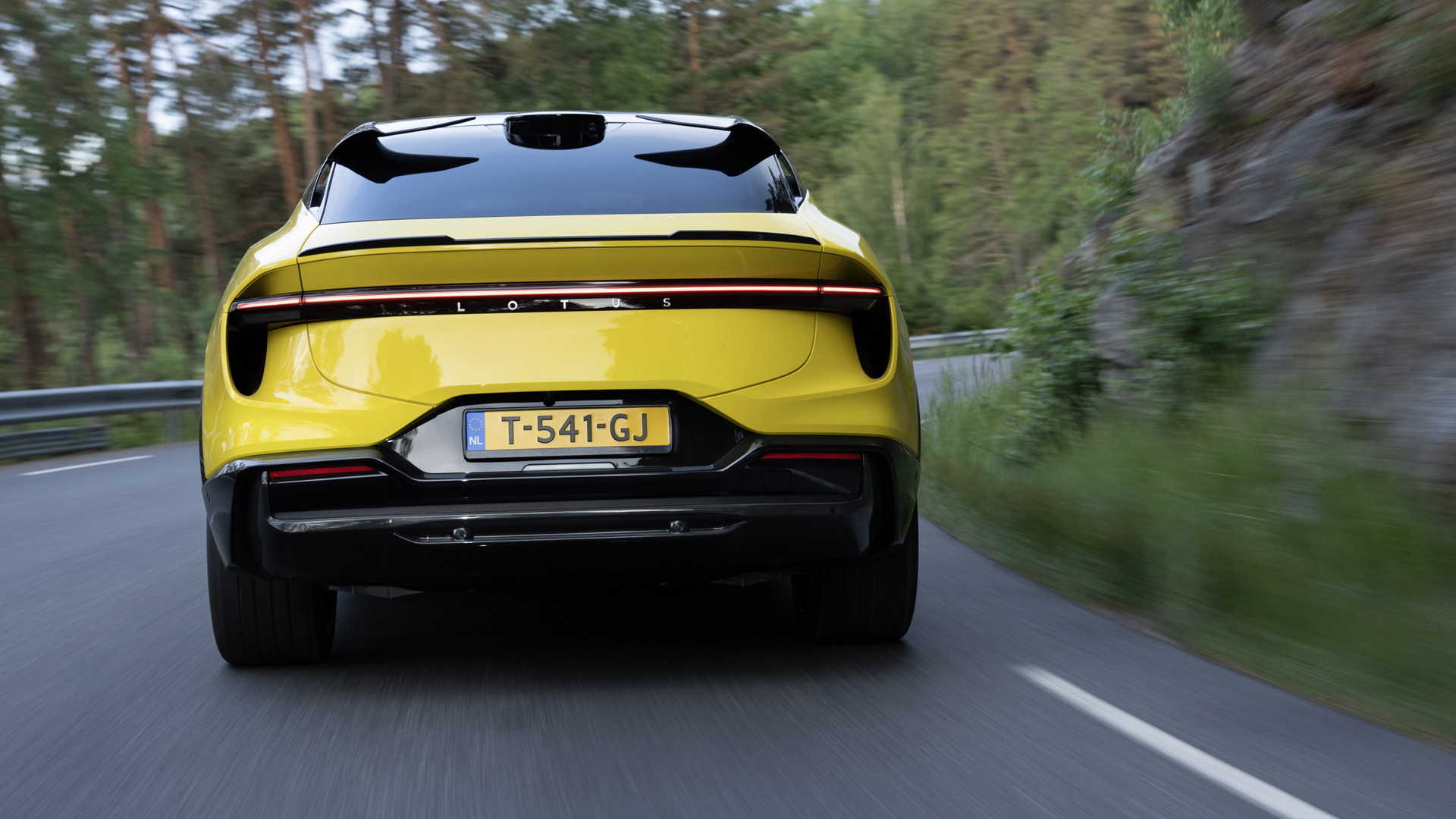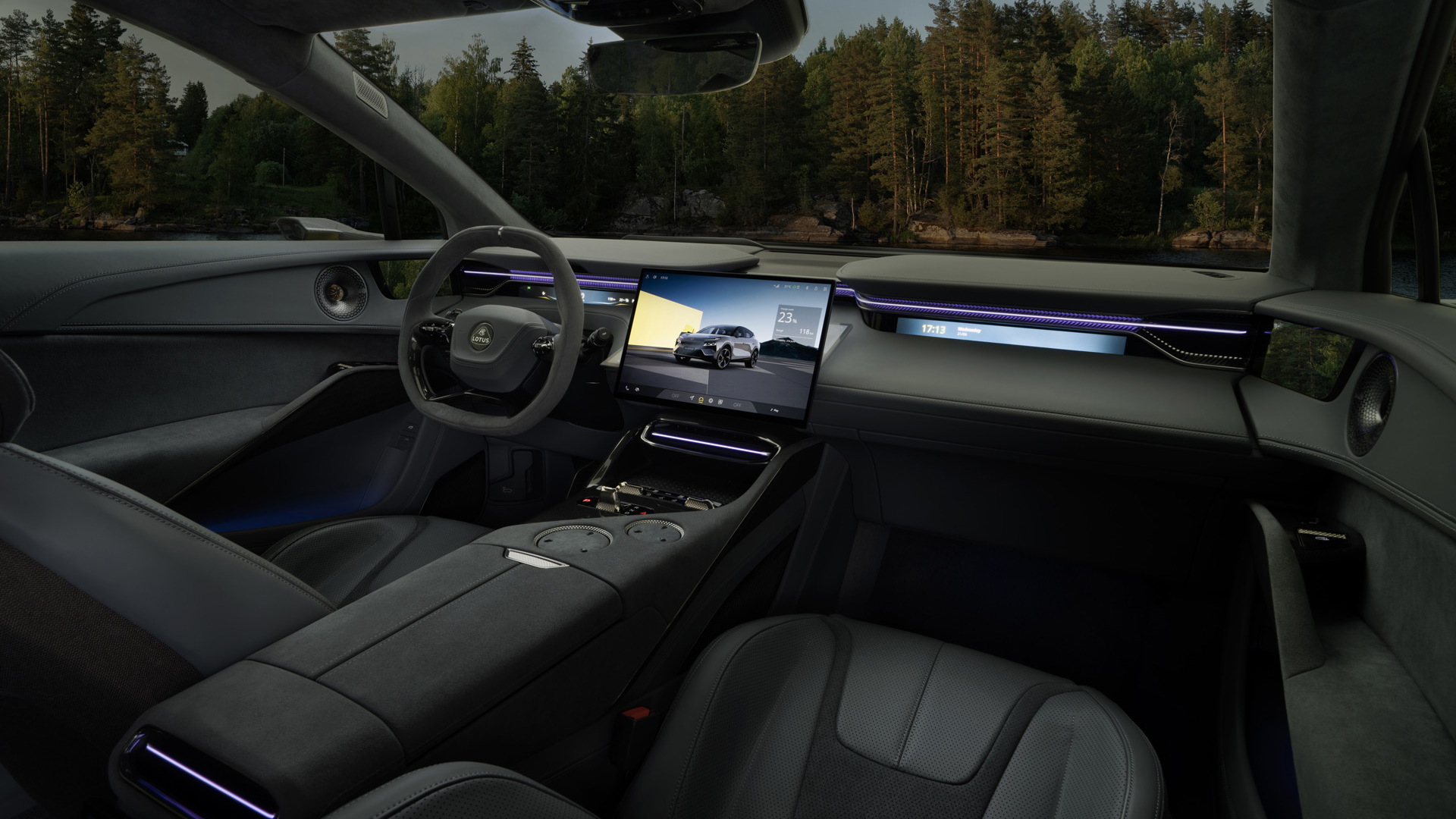Calling the Eletre a Lotus takes a big leap of faith. A large, heavy, electric SUV couldn’t be a greater departure from the lithe sports cars that drove Lotus into the hearts of enthusiasts everywhere. Just looking at this 2024 Lotus Eletre, you can imagine Colin Chapman rolling in his grave.
But Lotus—or, perhaps more importantly, Chinese parent company Geely—knows that niche little two-seaters do not a profitable car company make. So if Lotus wants to have the funding for special projects like the Evija hypercar, it has to balance that by making vehicles with greater mass-market appeal.
Thus the Eletre, though it certainly doesn’t look like any old mainstream SUV. The styling is wild, and the proportions are hard to gauge in photos. At 200.9 inches long, the Eletre is 2.1 inches longer than a Ford Explorer, but it has a low roofline that gives it more of a tall wagon vibe, especially in profile.
But at least that weird design serves a purpose. What this SUV lacks in outright beauty it makes up for with aerodynamic excellence. Every little vent and cut-through improves aero, and Lotus says the Eletre has an impressive drag coefficient of 0.26, making it one of the slipperiest SUVs on the road. This helps with the all-important driving range: As much as 373 miles, according to optimistic European WLTP testing, which will be greatly reduced under our stricter EPA standards.
Underneath the skin, the Eletre is relatively straightforward. There’s a 112-kwh lithium-ion battery pack arranged in the traditional skateboard style, which Lotus says can accept charging speeds of up to 350 kw—or perhaps more, the company was vague about this. Both the base version and midrange Eletre S have a dual-motor, all-wheel-drive setup producing 603 hp and 524 lb-ft of torque, allowing them to accelerate to 62 mph in 4.5 seconds. Not bad, considering the 5,500-pound curb weight.
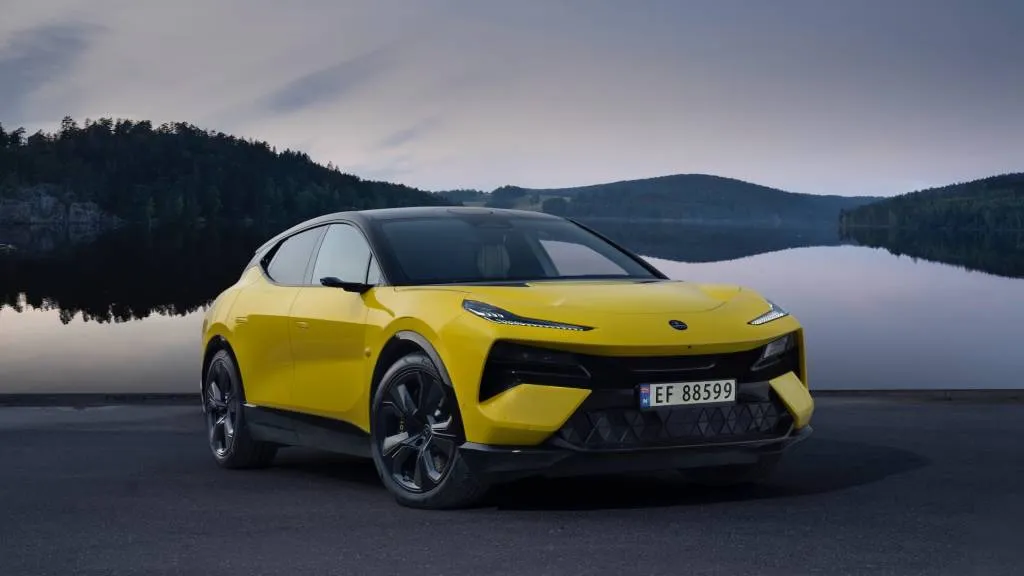
Lotus Eletre
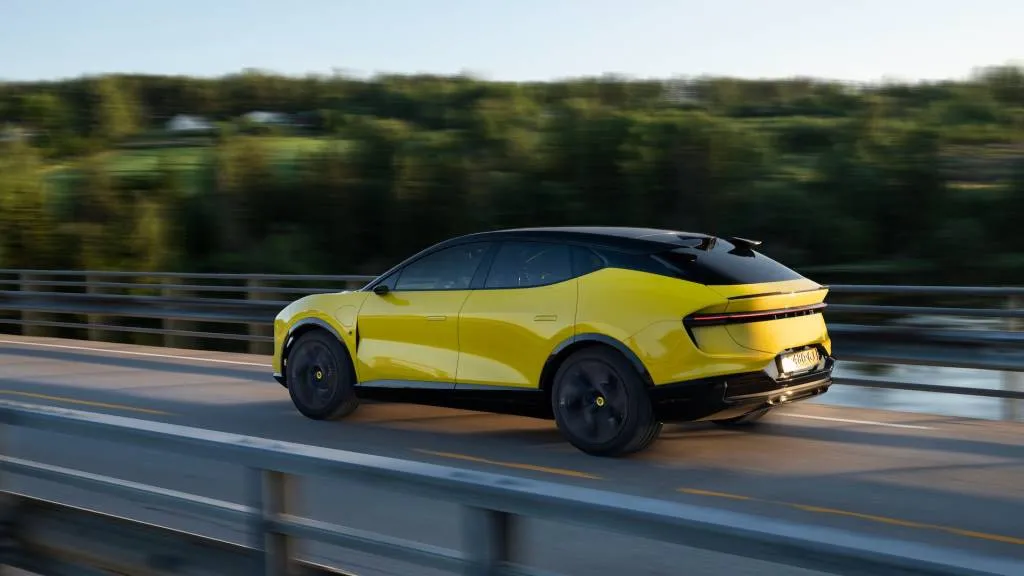
Lotus Eletre

Lotus Eletre
A higher-output Eletre R uses the same battery pack, but its rear electric motor has a 2-speed transmission, similar to the Porsche Taycan. The R offers 905 hp and 726 lb-ft of torque, reducing the 0-to-62 time to 2.9 seconds. But strangely, as quick as that is, launching the Eletre lacks thrill.
Hard launching a lot of performance EVs kind of feels like getting rear-ended by a semi truck in that it’s so instantaneous. But the Eletre takes a second—well, a millisecond, anyway—before it takes off. Once you do get up to higher speeds, the SUV gets a little unwieldy. The front end moves around a bit and the whole thing starts to feel floaty—something I never thought I'd say about a Lotus. That’s only at 100 mph, by the way; I’m not allowed to go any faster.
Lotus asked that I put the Eletre R in Sport mode for my two laps around a coned-off autocross course, so I can’t tell you if the Track setting makes any sort of meaningful difference on a, um, track. You can definitely feel the R’s 5,800-pound curb weight while cornering, but the standard active air suspension and 48-volt-powered active anti-roll bars do a nice job of smoothing out body motions The Eletre is eager to dive quickly into turns and feels well composed in an autocross setting.
The vast majority of my time in the Eletre is spent on Norway’s gorgeous and heavily speed regulated public roads, behind the wheel of an S. It accelerates smoothly and rides nicely, but because the roads around Oslo are so meticulously maintained, it’s tough to get a sense of how this thing would ride over broken pavement, especially equipped with the largest 22- or 23-inch wheels.
Four levels of regenerative braking are offered, and I toggle through them via what would be the left paddle shifter mounted to the steering wheel. The steps between these settings are noticeable, and while the heaviest-handed mode doesn’t completely allow for one-pedal driving, it’s pretty close. Transitioning to the mechanical brakes is a smooth process, with no sudden bite when the regen gives way to actual friction. The pre-selected regeneration setting stays the same when switching between Sport, Tour, and Range modes as well.
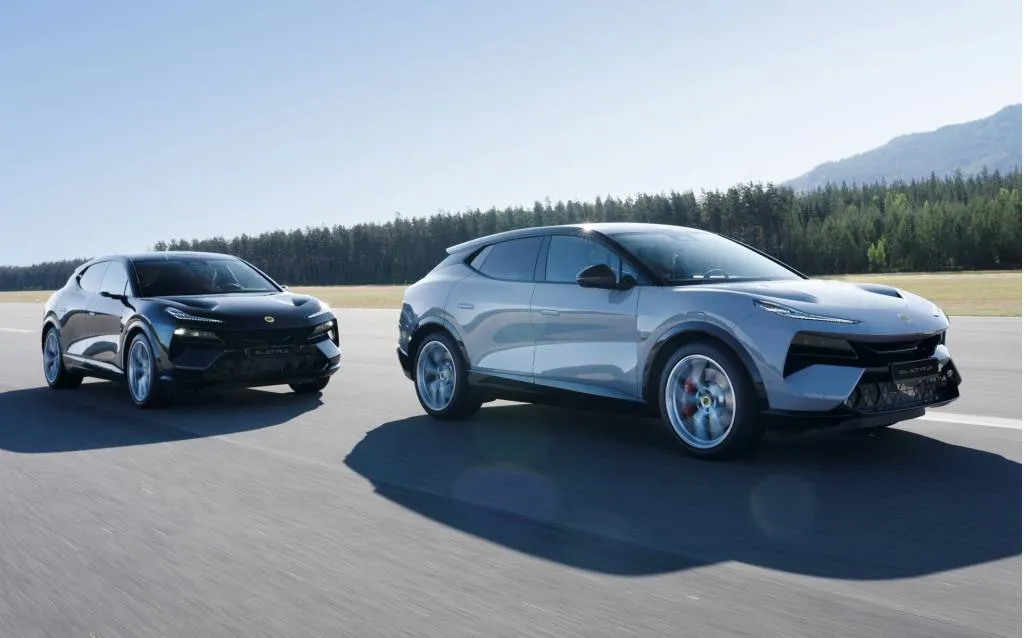
Lotus Eletre
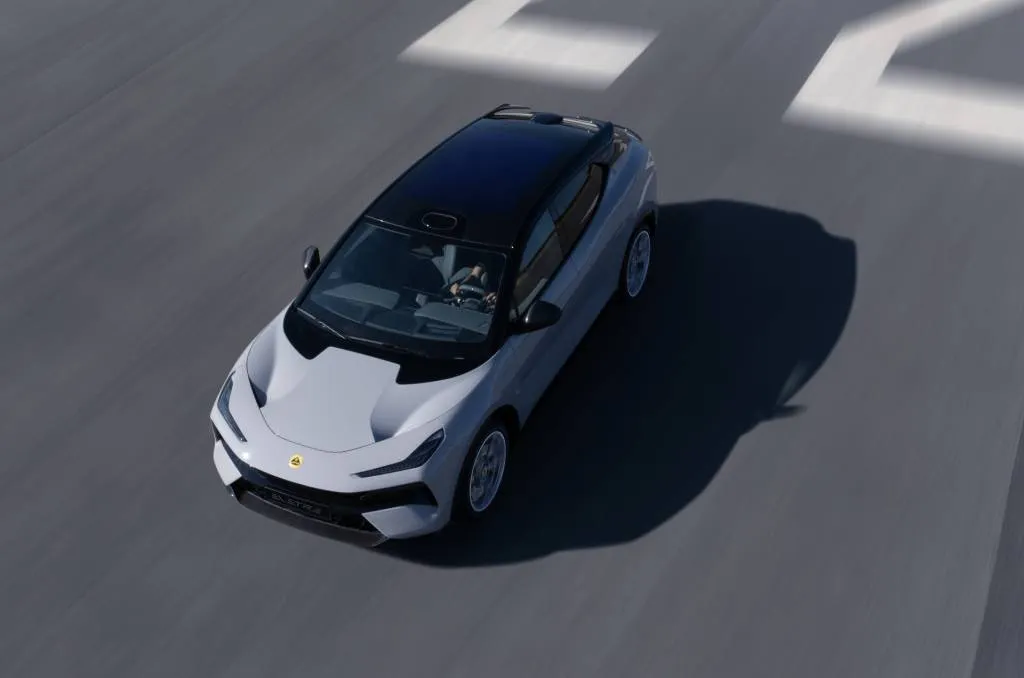
Lotus Eletre
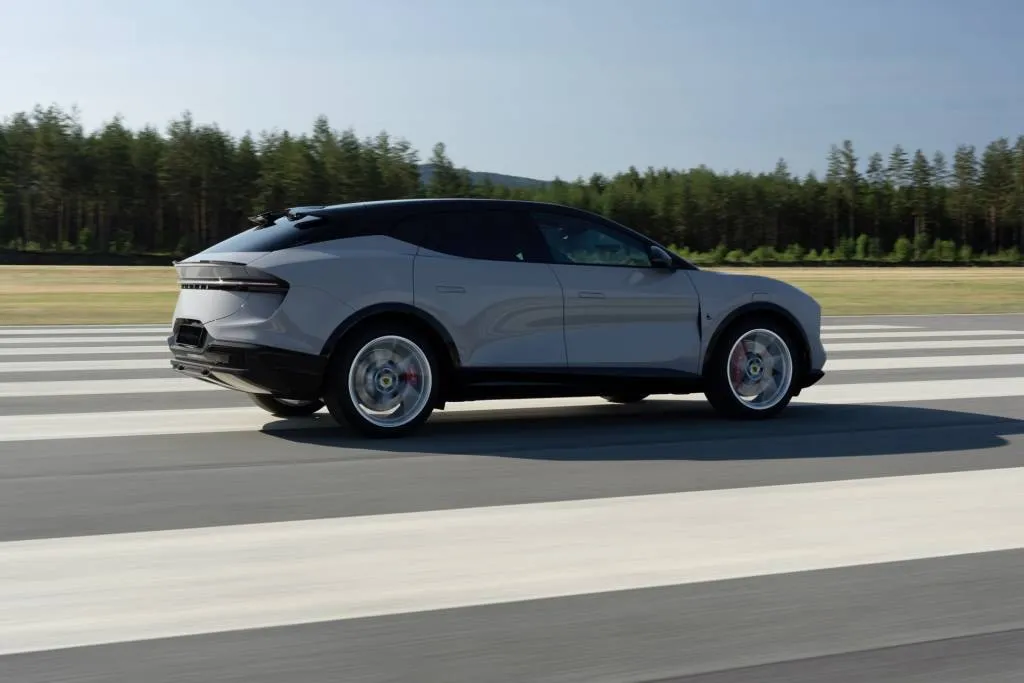
Lotus Eletre
Unfortunately, there’s not much more to say about the Eletre from a performance standpoint. At no point could I actually ever hustle the Eletre, given Norway’s penchant for placing speed cameras along public roads, and for the slow-moving Norwegian drivers who diligently obey the sluggish speed limits. I can tell you the steering is light but appropriately tuned for such a large SUV, and it’s quiet and comfortable enough inside that spending two days behind the wheel proves a cinch.
Well, mostly. If there’s one major quirk to the Eletre’s driving experience, it’s the driver-assistance technology. Look closely and you’ll notice a cut-out in the SUV’s roof just above the windshield; that’s where the pop-up lidar system is housed. Lotus fits this as standard to every Eletre, and while the SUV currently only has a basic list of functions—you can’t take your hands off the wheel a la GM’s Super Cruise—the company says this lidar prepares the vehicle for future autonomous applications. You can also hear it rising and lowering, which is annoying.
Using the adaptive cruise control and lane-departure warning tech is a bit of a mixed bag. The lane-departure warning system is incredibly sensitive; if you even get close to a side line, it’ll chime. The adaptive cruise, meanwhile, really needs to be smoothed out. On several occasions, the Eletre has a tough time regulating its own speed, quickly speeding up and slowing down in an attempt to keep a following distance from a lead car. It reminds me of riding in a New York taxi, where the driver uses the gas more like an on/off switch than an actual throttle. Hopefully, future over-the-air software updates will smooth out this issue.
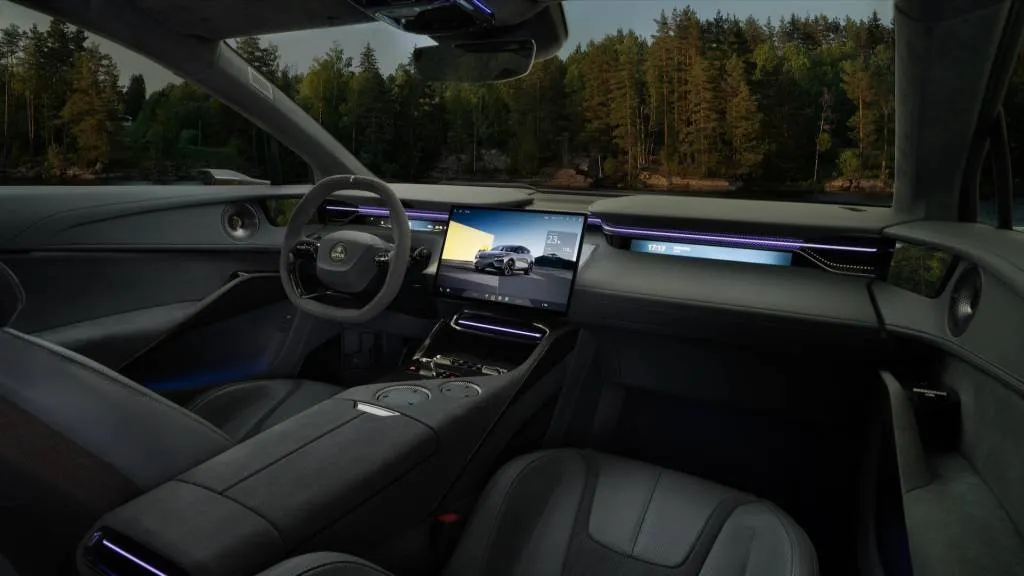
Lotus Eletre
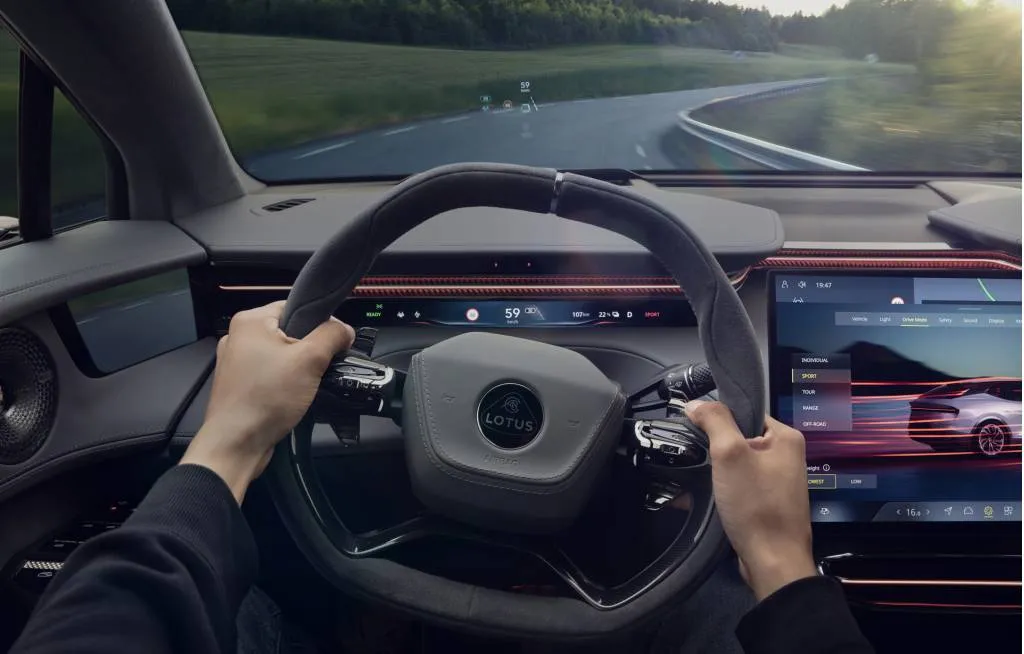
Lotus Eletre
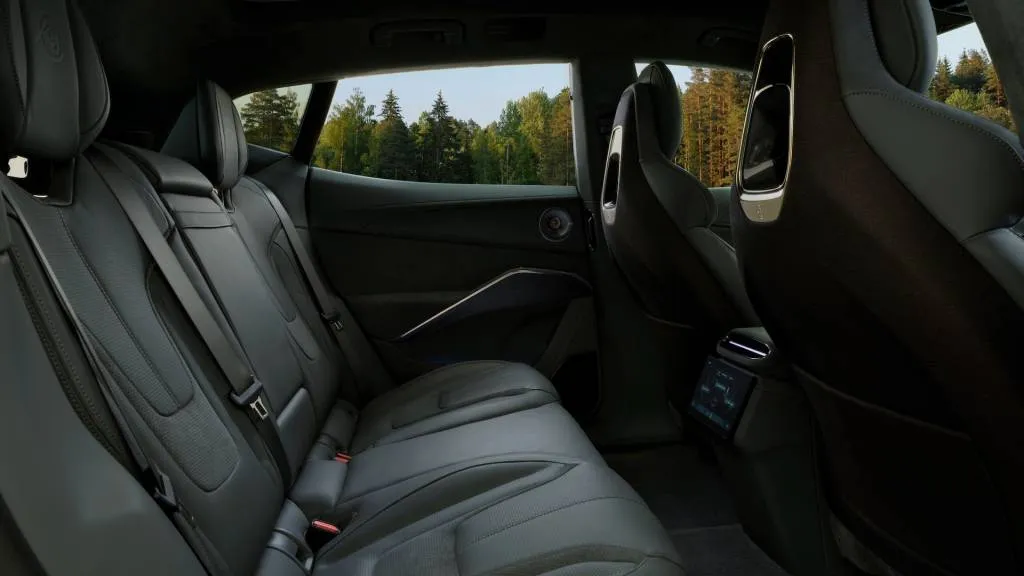
Lotus Eletre
One bit of tech that doesn’t need much work, however, is the central multimedia system. The 15.1-inch display is powered by Epic Games’ Unreal Engine, a bit of hardware that allows incredibly detailed and colorful graphics with excellent processing power, so responses to inputs are immediate. Lotus’ native infotainment design has somewhat of a steep learning curve, but it’s easy to get used to after awhile. You don’t have a choice in that matter, either; Apple CarPlay and Android Auto are not compatible (for now).
Lotus is incredibly proud of its combination KEF and Dolby Atmos surround-sound stereo—so much so, in fact, that it won’t let you change any of the audio settings. You cannot adjust the bass, treble, balance, or fader like you can in just about every other car on the planet. While the system is great for most tracks, anything bass-heavy becomes really bass-heavy, and this could be a problem if you have passengers (or pets) who are sensitive to certain vibrations or tones.
The driver has a wide but short 12.7-inch digital gauge screen, and a large head-up display projects redundant data onto the windshield. Weirdly, if you have an active navigation route, turn-by-turn directions do not appear in either of these driver displays, so you’ll have to rely on the audio prompts or central screen for route info. Passengers get their own 12.7-inch screen as well, but it’s extremely limited in functionality.
This SUV is incredibly well appointed, with a level of fit and finish you might not expect from Lotus—a company not necessarily known for its build quality. Soft leather surfaces blend with real metal switchgear, and Alcantara is available, too, if that’s your thing. The electrochromic sunroof automatically tints and untints based on the outside light conditions, and you can easily override this in the infotainment screen.
The Eletre can be optioned in four- or five-seat configurations, the former with two dedicated cut-outs in the rear as opposed to a straight-up bench. Both rows of seats have a ton of legroom, and headroom isn’t too bad, either, especially given the relatively short vehicle height. Behind the back bench, you’ll find 21.6 cubic feet of cargo space, which expands to 54.1 cubic feet with the seats folded flat.
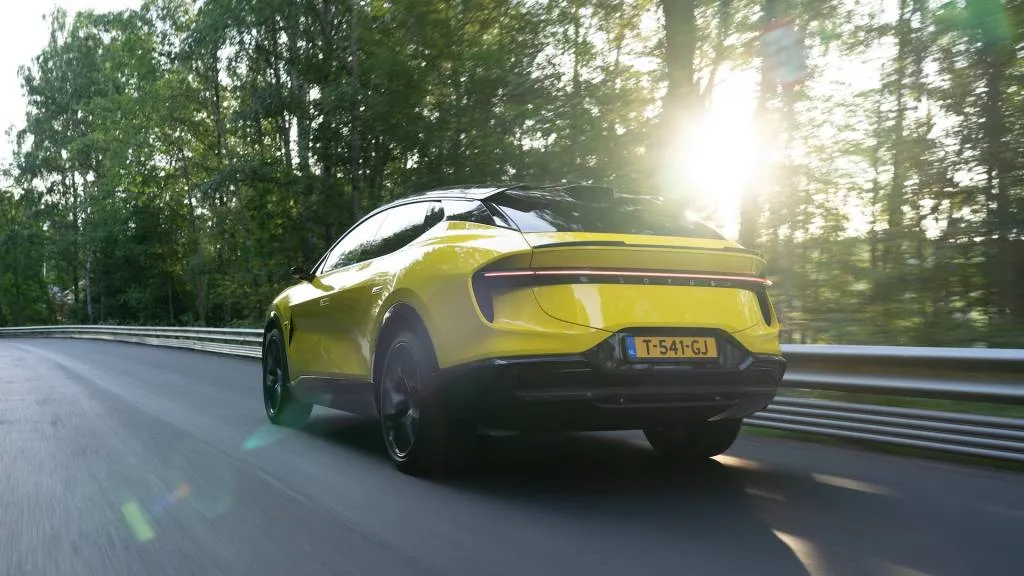
Lotus Eletre
All of this positions the Eletre as a pretty well-rounded electric luxury crossover, one that’s well positioned to take on the likes of the Mercedes-Benz AMG EQE SUV or BMW iX M60. Lotus hasn’t announced U.S. pricing for the Eletre yet, but it’ll likely start right around six figures, with the S commanding $120,000 and the R going for $140,000-$150,000.
So yes, it’s expensive, but the better question is: Where do you buy one? Lotus has a nearly nonexistent dealer network in the U.S., and while company officials say they’re working on rapidly improving this footprint, that stuff takes a lot of time. (Hello, Genesis.) There’s also not enough core Lotus-ness in the Eletre to appeal to die-hard brand loyalists—people who buy these cars for their simple, purist nature. They probably won’t jump through all the necessary hoops to get one of these.
There’s a lot to like about the Eletre. It’s a solid luxury EV that definitely stands out from the crowd. Is it a Lotus? Not really. Is it worth your attention? Absolutely.
—by Steven Ewing
Lotus paid for travel and lodging for Motor Authority to bring you this firsthand report.
